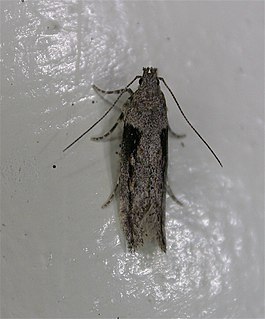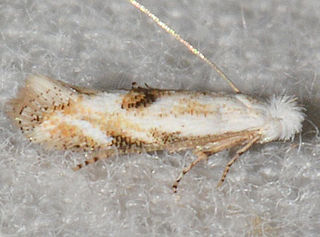
Symmetrischema is a genus of moths in the family Gelechiidae.
Bucculatrix quinquenotella is a species of moth of the family Bucculatricidae. It is found in North America, including Kentucky, Ohio, Michigan, Missouri, Iowa, Tennessee, Georgia, South Carolina, North Carolina, Washington D.C., New Jersey, Massachusetts, New Hampshire, Ontario, Quebec and Nova Scotia. It was described in 1875 by Vactor Tousey Chambers.

Bucculatrix montana is a moth in the family Bucculatricidae. It was described by Annette Frances Braun in 1920 and is found in North America, where it has been recorded from Ontario, Nova Scotia, Indiana, Maryland, Virginia, Ohio, Michigan, Maine, New York, New Jersey, Massachusetts and Georgia.
Bucculatrix polytita is a moth in the family Bucculatricidae. It is found in North America, where it has been recorded from Ontario and Quebec. It was described by Annette Frances Braun in 1963.
Bucculatrix eclecta is a moth in the family Bucculatricidae. It is found in North America, where it has been recorded from Ontario, New York, Maine and Indiana. It is also found in Russia. It was described by Annette Frances Braun in 1963.
Elachista staintonella is a moth of the family Elachistidae. It is found in the United States, where it has been recorded from Texas.

Elachista cana is a moth of the family Elachistidae. It is found in North America, where it has been recorded from Arizona, Colorado and Alberta.
Udea berberalis is a moth in the family Crambidae. It was described by William Barnes and James Halliday McDunnough in 1918. It is found in North America, where it has been recorded from California.
Apachea barberella is a moth in the family Depressariidae, and the only species in the genus Apachea. It was described by August Busck in 1902. It is found in North America, where it has been recorded from Montana, Colorado, New Mexico, Arizona, Utah and California.
Agonopterix latipalpella is a moth in the family Depressariidae. It was described by William Barnes and August Busck in 1920. It is found in North America, where it has been recorded from Texas.

Eucosma abstemia is a species of moth of the family Tortricidae first described by Edward Meyrick in 1932. It is found in the United States, where it has been recorded from Colorado, Arizona and California.
Telphusa nigrimaculata is a moth of the family Gelechiidae. It is found in North America, where it has been recorded from California.
Gnorimoschema collinusella is a moth in the family Gelechiidae. It was described by Vactor Tousey Chambers in 1877. It is found in North America, where it has been recorded from Colorado.
Gnorimoschema versicolorella is a moth in the family Gelechiidae. It was described by Vactor Tousey Chambers in 1872. It is found in North America, where it has been recorded from Kentucky.
Symmetrischema lectulifera is a moth in the family Gelechiidae. It was described by Edward Meyrick in 1929. It is found in North America, where it has been recorded Texas.
Symmetrischema fercularia is a moth in the family Gelechiidae. It was described by Edward Meyrick in 1929. It is found in North America, where it has been recorded Texas.
Symmetrischema lavernella is a moth in the family Gelechiidae. It was described by Vactor Tousey Chambers in 1874. It is found in North America, where it has been recorded Missouri, Texas, Illinois, Maine, Michigan, New Hampshire and the District of Columbia.
Aristotelia aquosa is a moth of the family Gelechiidae. It was described by Edward Meyrick in 1925. It is found in North America, where it has been recorded from Kentucky.

Aristotelia rubidella is a moth of the family Gelechiidae. It was described by James Brackenridge Clemens in 1860. It is found in North America, where it has been recorded from Alabama, Alberta, Arkansas, British Columbia, California, Florida, Georgia, Illinois, Indiana, Iowa, Kentucky, Louisiana, Maine, Manitoba, Maryland, Massachusetts, Michigan, Mississippi, New Jersey, North Carolina, Ohio, Oklahoma, Ontario, Quebec, South Carolina, Tennessee, Texas, Virginia, Washington, West Virginia and Wisconsin.
Monochroa robusta is a moth of the family Gelechiidae. It was described by Annette Frances Braun in 1921. It is found in North America, where it has been recorded from Ohio and South Carolina.




